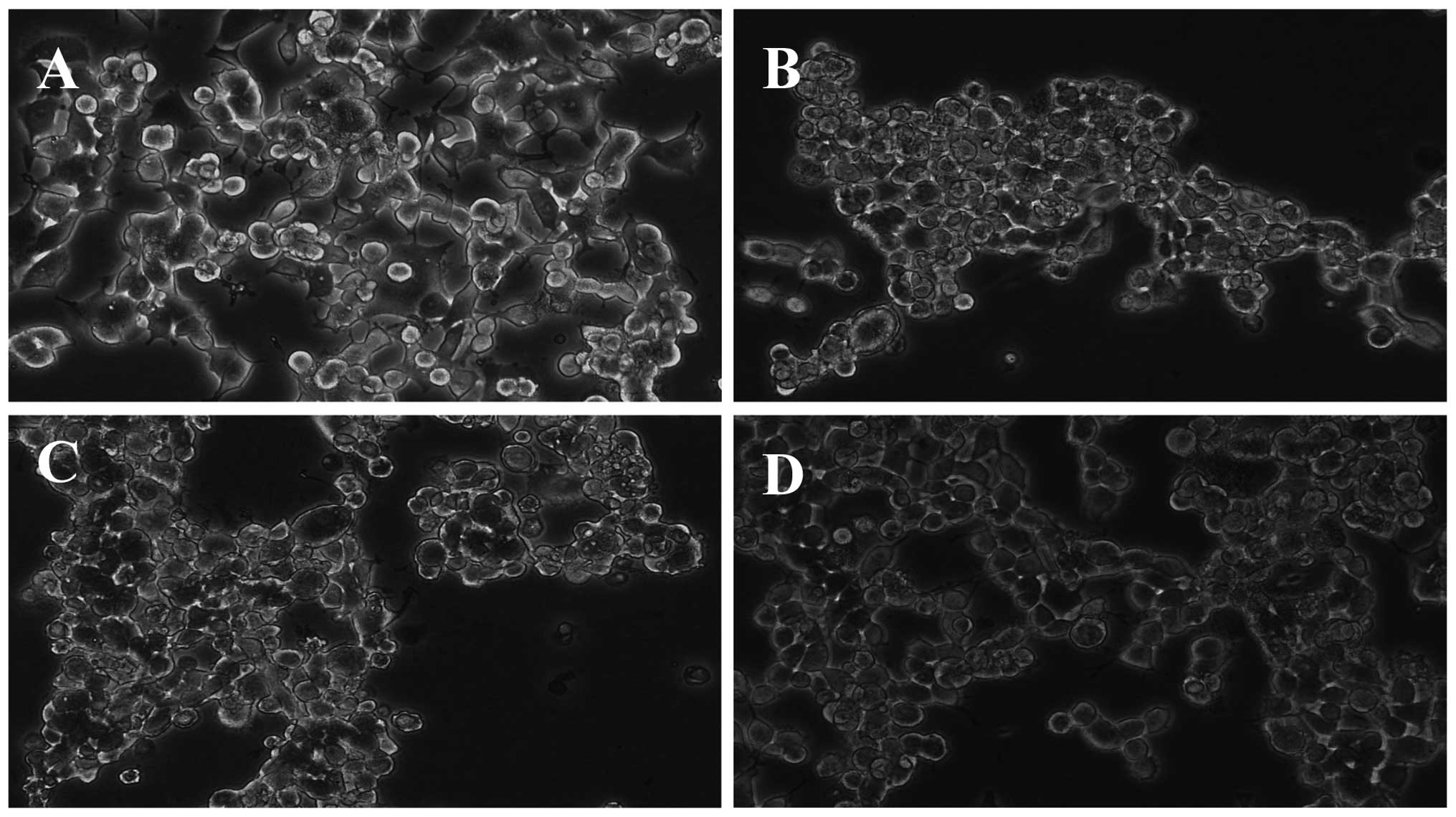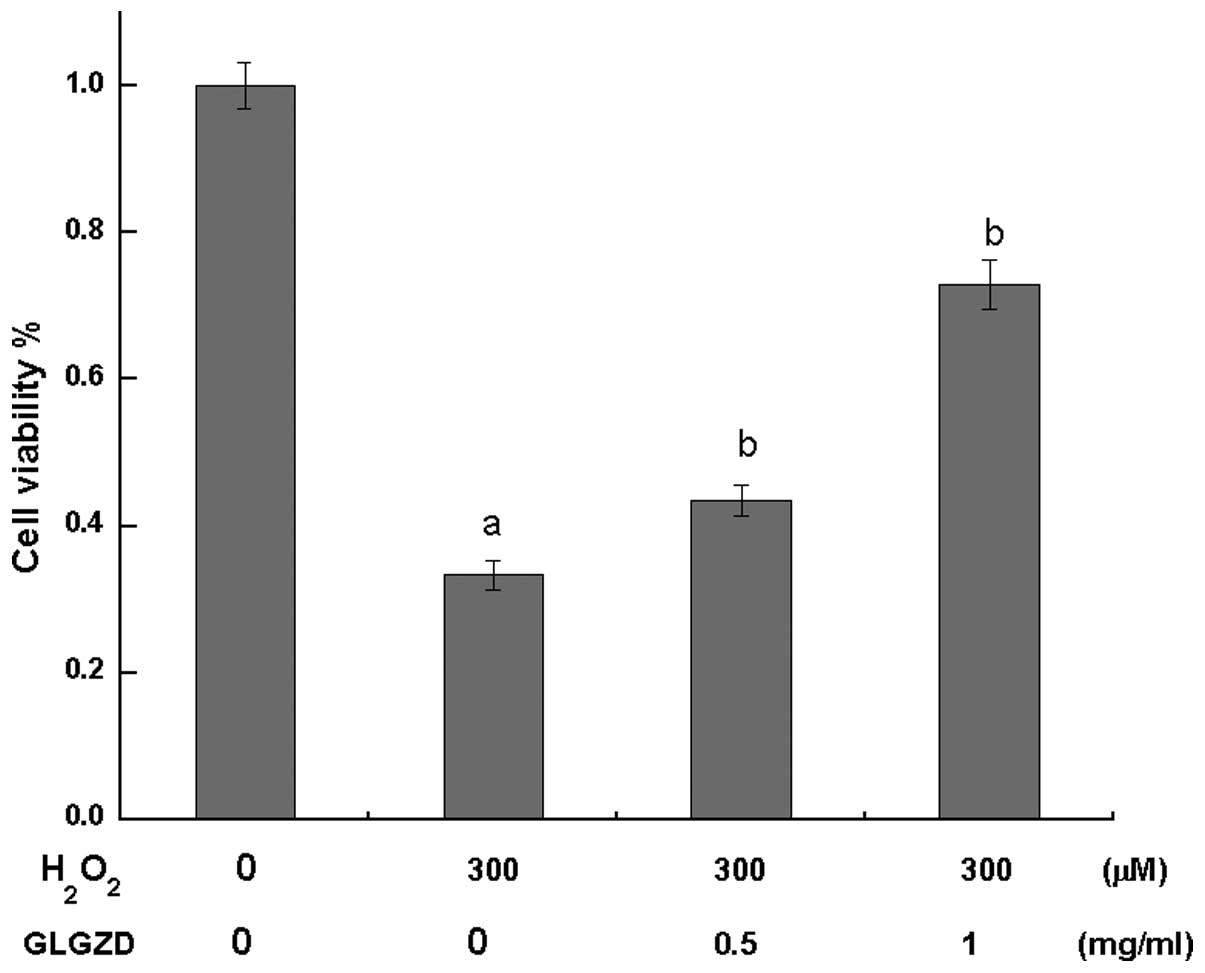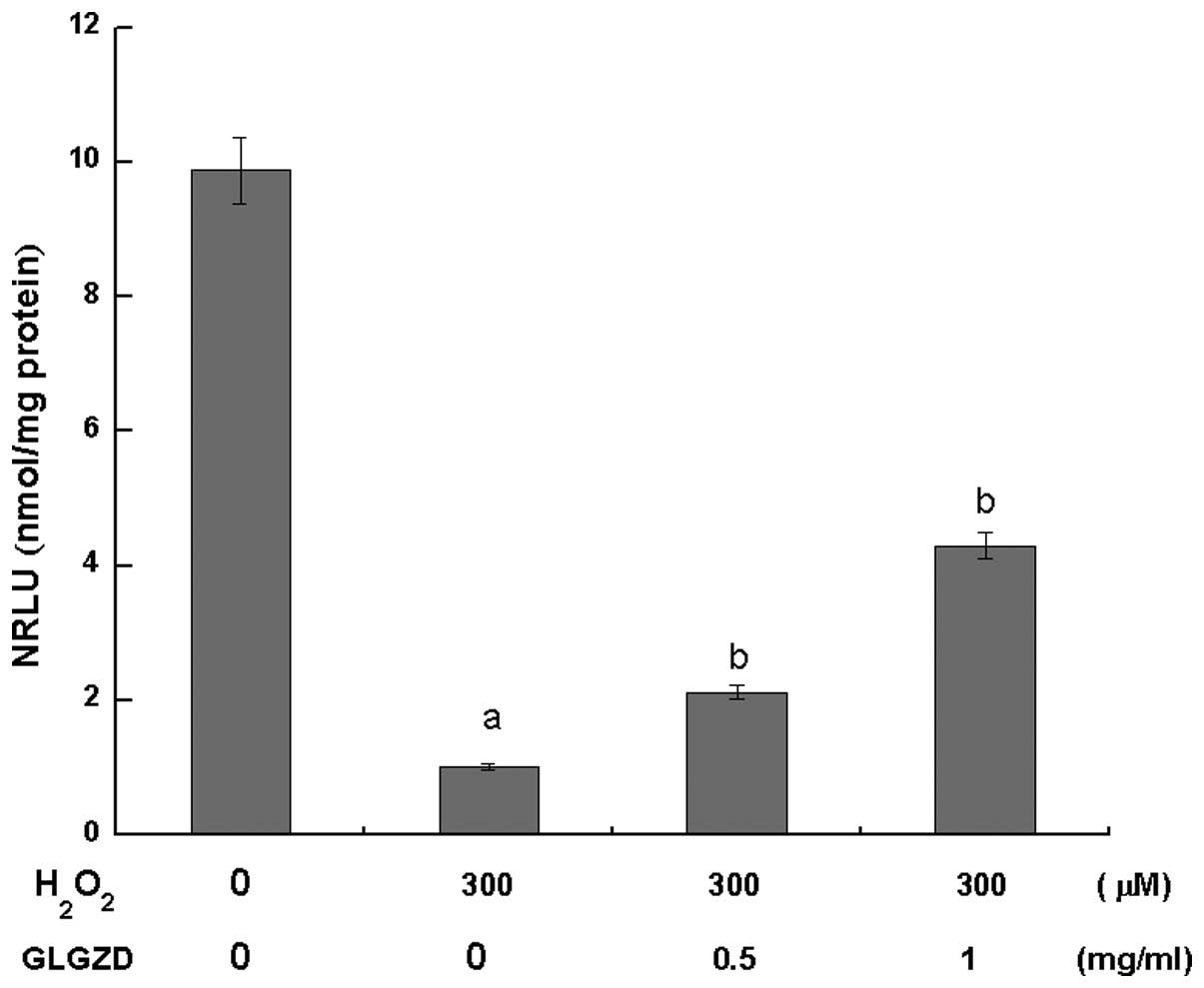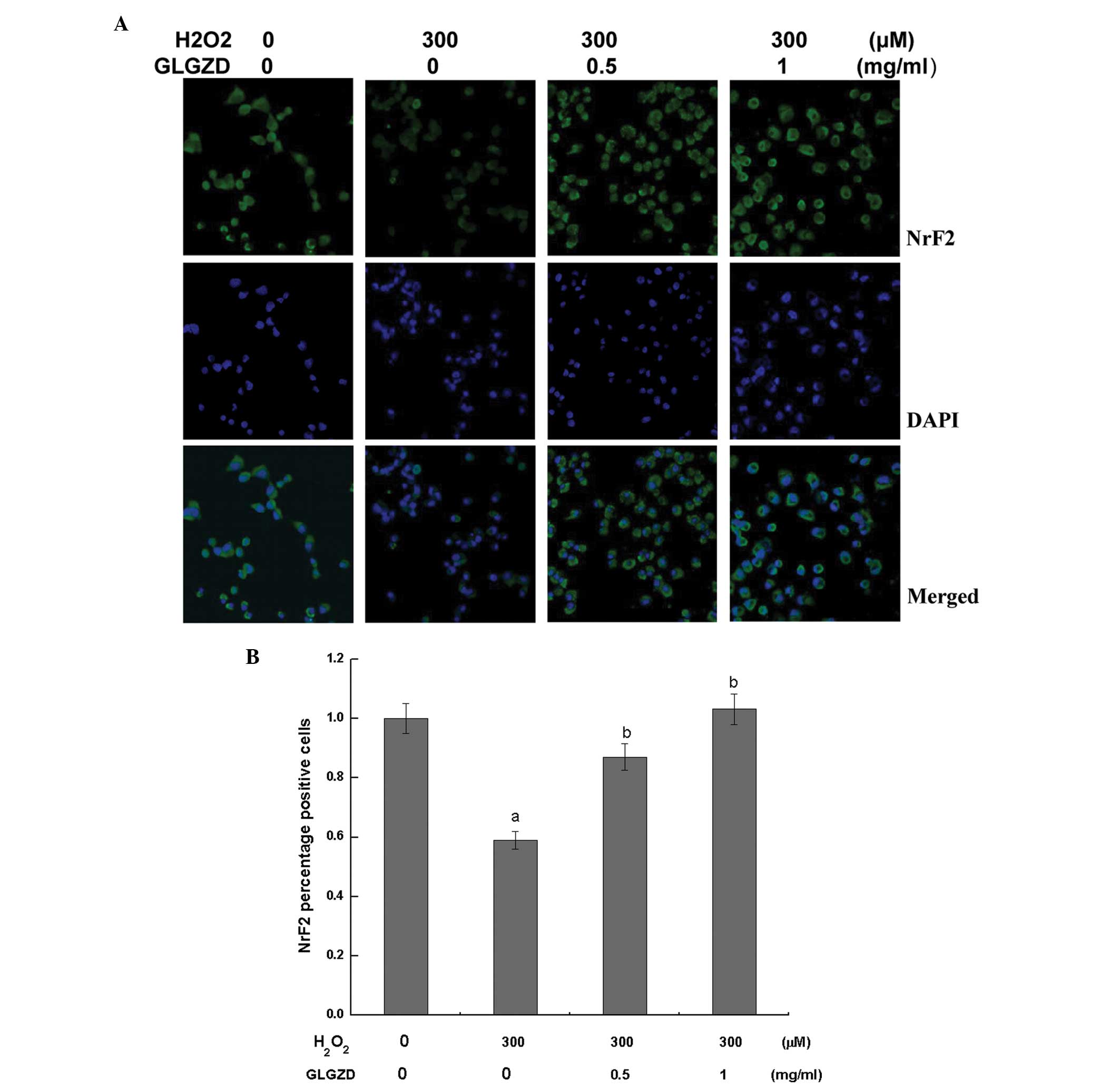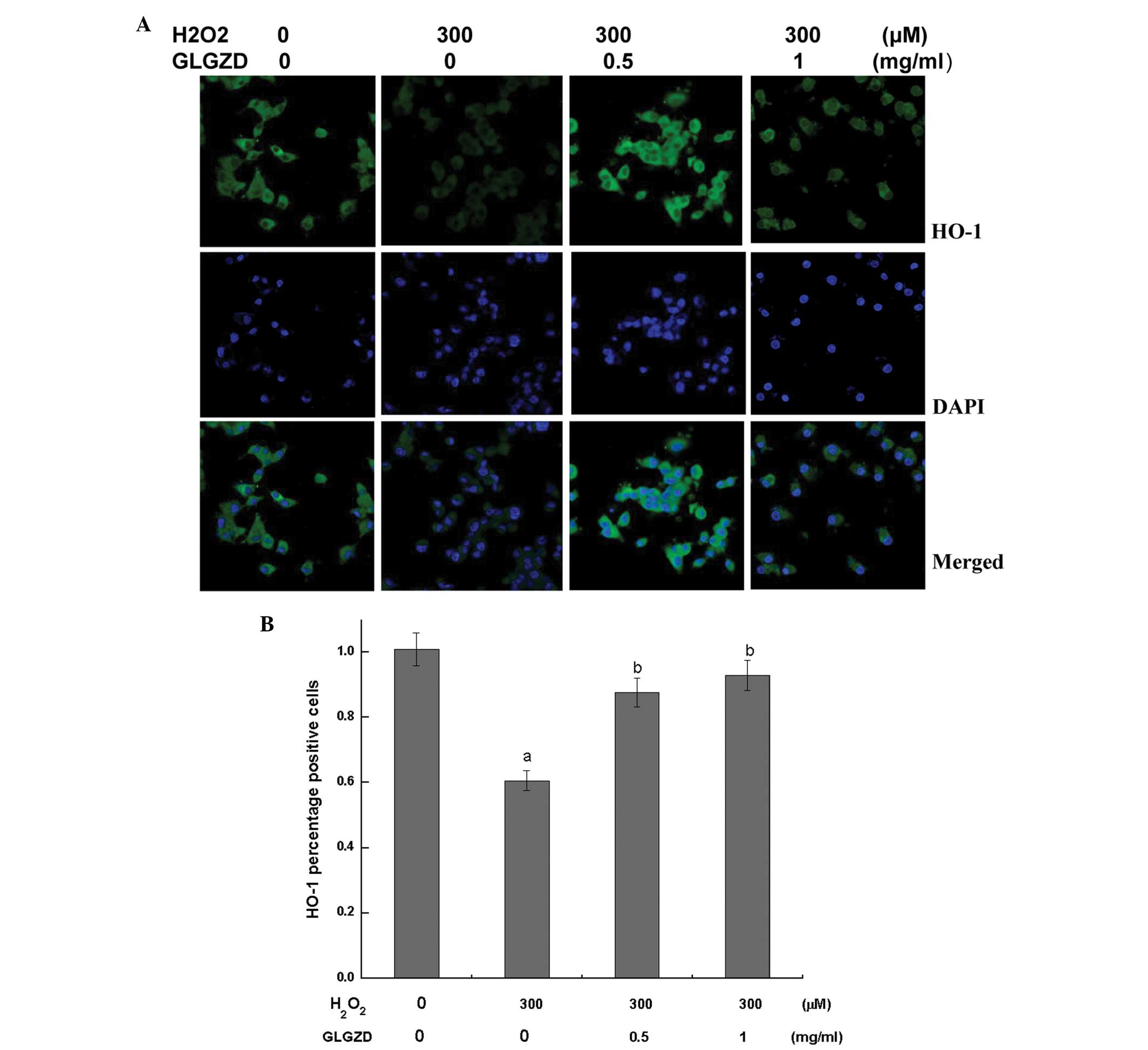Preconditioning with Gua Lou Gui Zhi decoction enhances H2O2‑induced Nrf2/HO‑1 activation in PC12 cells
- Authors:
- Published online on: July 1, 2015 https://doi.org/10.3892/etm.2015.2610
- Pages: 877-884
-
Copyright: © Mao et al. This is an open access article distributed under the terms of Creative Commons Attribution License.
Abstract
Introduction
Approximately 80% of patients with cerebral apoplexy sequelae are reported to have a certain degree of limb spasm (1), with a 38% higher incidence one year following a stroke (2). Although spasms can help certain patients with venous reflux and relieve edema, spasms hinder functional recovery in the majority of patients. If active treatment is not administered, permanent increased muscle tension and joint contracture can seriously impact on patient quality of life. Therefore, seizures that occur following a stroke remain an obstacle in stroke rehabilitation therapy (3).
Gua Lou Gui Zhi decoction (GLGZD) was originally prescribed during the Eastern Han Dynasty around 210 AD, as written in a famous traditional Chinese medicine (TCM) book, ‘Essentials from the Golden Cabinet’ (4). As outlined by Zhongjing Zhang in this book, the decoction comprised Radix Trichosanthis, Ramulus Cinnamomi, Paeonia lactiflora, Glycyrrhiza, Zingiber officinale Roscoe and Fructus Jujubae. As evidenced by the age of the documented prescription of GLGZD, this decoction has been used clinically for a number of years in China for the treatment of muscular spasticity following a stroke, epilepsy or a spinal cord injury (5,6). Previous studies have demonstrated that GLGZD is effective in the treatment of post-stroke spasticity, improving the Fugl-Meyer assessment and Barthel index scores (7,8). However, the mechanisms underlying the efficacy of GLGZD remain unclear.
Rat pheochromocytoma (PC12) cells have a similar morphology and function to sympathetic neurons in the presence of nerve growth factor (NGF), and subsequently have been widely utilized as a model for the study of neuronal ion channels and receptors, and responses to stress and injury (9). Oxidative stress is an important pathological consequence of stroke and ischemia-reperfusion injury. In addition, oxidative stress has been reported to be a core pathological component of stroke and brain ischemia-reperfusion injury, since oxidative stress elevates and contributes to cerebral ischemia reperfusion injury (10–12). A previous study found that within the brain microvasculature following ischemia-reperfusion injury, hydrogen peroxide (H2O2) is produced in excess, leading to an increased susceptibility of nerve cells to damage and the development of various neuropathies (13). The use of PC12 cells as a model of cerebral ischemia is similar to using primary neurons as an in vitro and in vivo model of a cerebral ischemia neural pathology (14). Therefore, the present study utilized H2O2 treatment of PC12 cells to stimulate oxidative stress in the neurons.
Nuclear factor (erythroid-derived 2)-like 2 (Nrf2) is a transcription factor that is involved in cellular protection against oxidative stress through the antioxidant response element (ARE)-directed induction of several antioxidant enzymes, including heme oxygenase (HO)-1 (15). HO-1 is a novel enzyme with potent anti-inflammatory, antioxidant and antiproliferative effects (16,17). Nrf2 and HO-1 proteins have been shown to play important neuroprotective roles in oxidative damage. Therefore, to clarify the potential mechanisms underlying the antispasticity effects mediated by GLGZD following stroke, the present study evaluated the antioxidant effects of GLGZD and investigated the underlying molecular mechanisms using PC12 cells injured by H2O2 in vitro. In the investigations of these mechanisms, the effects of GLGZD on the mRNA and protein expression levels of Nrf2 and HO-1 in PC12 cells injured by H2O2 treatment were analyzed.
Materials and methods
Preparation of the ethanol extract from GLGZD
GLGZD used in the study consisted of extracts of Trichosanthis Radix (9 g), Ramulus Cinnamomi (9 g), Paeonia lactiflora (9 g), Glycyrrhiza (6 g), Zingiber officinale Roscoe (9 g) and Fructus Jujubae (9 g), all in a ratio of 3:3:3:2:3:3. Dried crude medicinal plants were supplied by Guo Yi Tang Chinese Herbal Medicine Store (Fuzhou, Fujian, China) for the preparation of the GLGZD ethanol extract. A total of 300 g GLGZD was extracted with 3,000 ml ethanol (75%) using a reflux method, after which the solution was filtered. The ethanol solvent was evaporated on a rotary evaporator (model RE-2000; Yarong Biochemistry Instrument Co., Shanghai, China), and the GLGZD extract was obtained using a spraying desiccation method with a spray dryer (model B-290; Büchi Labortechnik AG, Flawil, Switzerland). The stock was stored at −20°C and working concentrations of GLGZD were established by dissolving the extract in culture media to a concentration of 8 mg/ml. Hydrogen peroxide (H2O2) was a product of Junsei Chemical Co., Ltd. (Tokyo, Japan).
Cell culture and NGF-induced differentiation of PC12 cells
A PC12 rat pheochromocytoma cell line was obtained from the American Type Culture Collection (Rockville, MD, USA). The cells were maintained in RPMI 1640 medium supplemented with 10% heat-inactivated horse serum, 5% fetal bovine serum, 100 U/ml penicillin and 100 µg/ml streptomycin, which were all purchased from Gibco Life Technologies (Carlsbad, CA, USA), in a 37°C humidified incubator with 5% CO2 (Thermo Fisher Scientific, Waltham, MA, USA). After 24 h of incubation, differentiation was induced by treatment with 50 ng/ml NGF (NGF 2.5S; EMD Millipore, Madison, WI, USA) every other day for 6 days.
Drug treatment
All the experiments were performed 24 h following cell seeding onto plates at a density of 1×105 cells/ml. H2O2 was freshly prepared prior to each experiment. Cells were preincubated with GLGZD at the various concentrations (0.5 and 1.0 mg/ml) for 24 h prior to exposure to 300 µM H2O2 for 4 h. The control and H2O2 treatment groups were cultured in an equal volume of RPMI 1640 medium without or with H2O2, respectively. Subsequently, assays for cell survival and other cellular properties were performed as follows.
Analysis of cell viability
Cell survival was observed using an inverted microscope (Leica Microsystems GmbH, Wetzlar, Germany). Cell viability was simultaneously evaluated with a 3-(4,5-dimethyl-2-thiazolyl)-2,5-diphenyltetrazolium bromide (MTT) assay obtained from Sigma-Aldrich (St. Louis, MO, USA). PC12 cells were seeded into 96-well plates at a concentration of 1×105 cells/ml, and subsequently treated with or without 300 µM H2O2 for 4 h following the addition of GLGZD at 0.5 and 1 mg/ml for 24 h at 37°C. After incubation for 3 h with 20 µl MTT (5 mg/ml), the cells were lysed in dimethyl sulfoxide (Sigma-Aldrich), and the amount of MTT formazan was qualified by determining the absorbance at 570 nm using a microplate reader (Bio-Rad Laboratories, Inc., Hercules, CA, USA). Cell viability was expressed as a percentage of the control culture value.
Cellular ATP level determination
PC12 cells were plated in a six-well cell culture plate overnight and incubated with GLGZD ethanol extract (0.5 and 1 mg/ml) for 24 h prior to exposure to, or absence of, H2O2 (300 µM) for 4 h. The levels of ATP in the cells were measured using a firefly luciferase-based ATP assay kit (Beyotime Institute of Biotechnology, Shanghai, China), according to the manufacturer's instructions. PC12 cell culture and GLGZD exposure were performed as aforementioned. After rinsing with phosphate-buffered saline (PBS), the cells were disrupted in 200 µl lysis buffer, and centrifuged at 12,000 × g at 4°C for 5 min, from which the supernatant was collected. In a 1.5-ml tube, a 100-µl sample of the supernatant was mixed with 100 µl ATP detection working solution. The luminance (RLU) was immediately measured using a Turner BioSystems luminometer (Promega Corporation, Madison, WI, USA). Standard curves for quantification were generated using known amounts of an ATP standard, and the protein concentration of each treatment group was determined using a bicinchoninic acid protein assay kit (Beyotime Institute of Biotechnology). Total ATP levels were expressed as normalized luminance (NRLU) in nmol/mg protein (18).
Reverse transcription quantitative polymerase chain reaction (PCR) for Nrf2 and HO-1 mRNA expression
Total RNA was isolated from the PC12 cells using TRIzol reagent (Invitrogen Life Technologies, Carlsbad, CA, USA), according to the manufacturer's instructions. In total, 1 µg RNA was reverse transcribed into cDNA using a RevertAid™ H Minus First Strand cDNA Synthesis kit (Fermentas GmbH, St. Leon-Rot, Germany). The total volume of the reverse transcription reaction mixture was 20 µl cDNA, then 2 µl cDNA was used for each amplification. cDNA was amplified by quantitative PCR (50°C for 2 min, 95°C for 10 min followed by 40 cycles of 95°C for 15 sec and 60°C for 1 min) using an ABI Prism 7500 Sequence Detector (Applied Biosystems Life Technologies, Foster City, CA, USA) with SYBR Green Real-Time PCR Master Mix Reagent (Takara Bio, Inc., Otsu, Japan). Data from the reaction were collected and analyzed using Sequence Detector Software (SDS version 1.6; PE Applied Biosystems, Foster City, CA USA). Relative quantification of gene expression was calculated using the 2−ΔΔCt data analysis method and normalized against GAPDH for each sample. The sequences of the primers used for PCR were as follows: Nrf2 forward, 5′-CCA TTT ACG GAG ACC CAC-3′ and reverse, 5′-TGA GCG GCA ACT TTA TTC-3′; HO-1 forward, 5′-GAA ACA AGC AGA ACC CAG TC-3′ and reverse, 5′-AGA GGT CAC CCA GGT AGCG-3′; GAPDH forward, 5′-ACG GAT TTG GTC GTA TTG GGC-3′ and reverse, 5′-CTC GCT CCT GGA AGA TGG TGAT-3′. GAPDH was selected as the housekeeping gene.
Fluorescent immunohistochemistry
Differentiated PC12 cells were seeded into confocal-specific sterile glass-bottom cell culture Petri dishes (15 mm diameter; Nest Biotechnology Co., Ltd., Wuxi, China) and cultured for 24 h. The cells were treated with different concentrations of GLGZD (0.5 and 1.0 mg/ml), or received no treatment, for 24 h, followed by incubation with 300 µM H2O2 for 4 h. Subsequently, the cells were fixed with 4% paraformaldehyde in PBS (pH 7.4; Gibco Life Technologies) for 30 min and permeabilized in 0.1% Triton X-100 in PBS for 10 min at room temperature. Nonspecific binding was blocked with 5% goat serum in PBS for 30 min. Next, the cells were incubated at 4°C overnight with the following primary antibodies: Rabbit anti-Nrf2 (1:100 polyclonal; cat. no. SC-13032; Santa Cruz Biotechnology, Inc. Santa Cruz, CA, USA) and rabbit anti-HO-1 (1:200 polyclonal; cat. no. SC-10789; Santa Cruz Biotechnology, Inc.). Following incubation with the primary antibodies, the cells were washed three times in cold PBS and incubated with a goat anti-rabbit secondary antibody conjugated to a fluorescent marker (1:100, Alexa 488; Abcam, Cambridge, MA, USA). The cells were mounted with 4,6-diamidino-2-phenylindole (1:1,000; Beyotime Institute of Biotechnology) to stain the nuclei, and the samples were analyzed using an LSM 710 laser scanning confocal microscope under 40 × water objective (Carl Zeiss AG, Oberkochen, Germany).
Statistical analysis
Data were analyzed using SPSS 17.0 software (SPSS, Inc., Chicago, IL, USA). Quantitative data are expressed as the mean ± standard deviation of at least triplicate experiments. One-way analysis of variance was used for data comparisons between multiple groups, where P<0.05 was considered to indicate a statistically significant difference.
Results
Effects of GLGZD on the viability of H2O2-treated PC12 cells
Neuroprotective effects of GLGZD were further confirmed by the morphological observations (Fig. 1). Following incubation with 50 µg/ml NGF for 6 days, the morphological observations indicated that the majority of the NGF-differentiated PC12 cells had ceased division and extended their neuritic processes (Fig. 1A). Exposure to H2O2 for 4 h resulted in heterogeneity in their shape, a loss of connections between neural cells and extensive detachment from the culture plate. As shown in Fig. 1B, the PC12 cell number markedly decreased, with the majority of the cells darkened or shrunken, and a number of the treated cells were even fragmented and yielding debris after 4 h exposure to 300 µM H2O2. Pretreatment with GLGZD was shown to alleviate the damage induced by H2O2. Based on the morphological changes, 1 mg/ml GLGZD (Fig. 1D) exerted a greater protective effect compared with 0.5 mg/ml GLGZD (Fig. 1C). Since the PC12 cells were very sensitive to H2O2, pretreatment with GLGZD (0.5 and 1.0 mg/ml) for 24 h dose-dependently increased cell viability compared with cells treated with H2O2 alone, as determined by the MTT assay (Fig. 2).
Changes in the cellular ATP levels
After 4 h of H2O2 exposure, the ATP levels in the two GLGZD treatment groups were significantly higher (P<0.05) compared with the group of cells treated with H2O2 alone. However, the ATP levels were significantly lower in these groups when compared with the control group (Fig. 3).
GLGZD protects PC12 cells against H2O2-induced oxidative stress injury
To determine the mechanism by which GLGZD attenuated H2O2-induced cell damage, the mRNA expression levels of Nrf2 and HO-1 were determined by quantitative PCR analysis (Fig. 4). Amplification curves of Nrf2 and HO-1 mRNA expression in the PC12 cells are shown in Fig. 4A. In SYBR green real-time quantitative PCR-based melt-curve analysis each gene of real-time fluorescent quantitative PCR is a single peak, the dissolution of instructions are specific amplification (Fig. 4B). Statistically significant decreases in the mRNA expression levels of Nrf2 and HO-1 were observed in the cells treated with H2O2 alone, as compared with the control cells. Conversely, the mRNA expression levels of Nrf2 and HO-1 were significantly increased following treatment with 0.5 or 1.0 mg/ml GLGZD, as compared with the cells treated with H2O2 alone. Simultaneously, antibodies specific to the activated forms of Nrf2 and HO-1 were utilized to assess the protein expression levels, since Nrf2 and HO-1 can protect nerves against oxidative injury (16). Using confocal fluorescent microscopy, fluorescent labeling of the antibodies targeting the Nrf2 and HO-1 proteins was observed to be markedly weaker in the group of cells treated with H2O2 alone when compared with the control and GLGZD treatment groups. Alternatively, the GLGZD treatment groups exhibited a higher fluorescence intensity compared with the H2O2 treatment group (Figs. 5 and 6).
Discussion
TCMs, including Chinese herbs, such as Buyang Huanwu decoction (19), Guizhi Fuling capsules (20), Xiaoxuming decoction (21), Danggui-shaoyao-san (22) and Yi-Gan-San (23), use compounds extracted from natural products and have a relatively safe side-effect profile compared with modern chemotherapeutics. In addition, such traditional therapies have been used for millennia as alternative treatments for various diseases and maladies. GLGZD is a classical TCM that was first prescribed in the first century during the Eastern Han Dynasty. Supporting the historic utilization and efficacy of this traditional medicine, GLGZD was previously demonstrated to exhibit considerable therapeutic effects on spasticity in stroke patients. The anti-inflammatory and antiapoptotic mechanisms of GLGZD have been shown to reduce the neurotoxicity of excitatory amino acids, which lowers limb spasticity following a stroke (24–26). In the assessment of cell viability, a tetrazolium salt, MTT, is cleaved to form formazan by the mitochondrial respiratory chain enzyme, succinate dehydrogenase, in living cells. In the present study, an MTT assay was performed to assess the cell viability, and the results demonstrated that following PC12 cell differentiation, pretreatment with GLGZD at 0.5 or 1 mg/ml for 24 h clearly protected the cells from damage caused by H2O2, and improved the overall cell survival rate (Fig. 2). In addition, morphological observations using inverted microscopy revealed that GLGZD treatment improved H2O2-induced cell narrowing, with the cells appearing round or polygonal, with an increased cell diopter, cell connectivity and adherent conditions (Fig. 1). Measurement of ATP levels is a classic method for the assessment of cell mitochondrial function and condition, and the results of the present study revealed that GLGZD pretreatment in the PC12 cells significantly elevated the levels of ATP in the injury model group, indicating that GLGZD is able to reduce the extent of H2O2 damage inflicted on the mitochondria in PC12 cells (Fig. 3).
Activation of the Nrf2/ARE signaling pathway has been shown to exert a protective effect on cerebral ischemia reperfusion injury, and high levels of Nrf2 and HO-1 resistance in the central nervous system are known to invoke key internal and external oxidation protection (27). Dietz et al reported that Nrf2, through interacting with the ARE, altered the expression of coding antioxidants and detoxifying enzymes, which subsequently protected cells against oxidative stress (28). Currently, the Nrf2/ARE pathway appears to be the most important endogenous antioxidant stress pathway (29). Nrf2 regulates the cell oxidation stress reaction of important transcription factors through interacting with oxidation reaction components, such as the ARE, which subsequently affects the coding of antioxidants, and the pathways activated can trigger the downstream expression of HO-1 and other protective genes, fully enhancing the cell protection activities (30,31). In the present study, the reverse transcription quantitative PCR results revealed that preconditioning with different concentrations of GLGZD upregulated the mRNA expression levels of Nrf2 and HO-1 in H2O2-damaged PC12 cells (Fig. 4). In addition, the confocal laser scanning microscopy data indicated that preconditioning with GLGZD enhanced the protein expression levels of Nrf2 and HO-1 in H2O2-injured PC12 cells (Figs. 5 and 6).
In conclusion, the results of the present study demonstrated that GLGZD is able to protect PC12 cells from H2O2-induced damage, which may be associated with the observed upregulation of the gene and protein expression levels of Nrf2 and HO-1. Therefore, prompt antioxidant therapy may be a therapeutic option to target one of the important mechanisms underlying spasticity following a stroke. To the best of our knowledge, the present study has reported for the first time that GLGZD exerts a neuroprotective effect against H2O2-induced nerve cell damage. These results provide evidence that GLGZD may be a potential therapeutic agent for the treatment of post-stroke neuronal cell death and spasticity.
Acknowledgements
This study was supported by grants from the Guidance Project of the Fujian Provincial Department of Science and Technology (no. 2012D012), the Natural Science Foundation of Fujian Province (no. 2013J01378), the Project of Fujian Education Department (no. JK2012216) and the Project of Fujian Education Department (no. JA2012179).
Glossary
Abbreviations
Abbreviations:
|
GLGZD |
Gua Lou Gui Zhi decoction |
|
Nrf2 |
nuclear factor (erythroid-derived 2)-like 2 |
|
HO |
heme oxygenase |
|
H2O2 |
hydrogen peroxide |
|
PCR |
polymerase chain reaction |
|
NGF |
nerve growth factor |
|
ARE |
antioxidant response element |
|
TCM |
traditional Chinese medicine |
References
|
Elovic E: Principles of pharmaceutical management of spastic hypertonia. Phys Med Rehabil Clin N Ant. 12:793–816. 2001. | |
|
Watkins CL, Leathley MJ, Gregson JM, Moore AP, Smith TL and Sharma AK: Prevalence of spasticity post stroke. Clin Rehabil. 16:515–522. 2002. View Article : Google Scholar : PubMed/NCBI | |
|
Duncan PW, Zorowitz R, Bates B, et al: Management of adult stroke rehabilitation care: A clinical practice guideline. Stroke. 36:e100–e143. 2005. View Article : Google Scholar : PubMed/NCBI | |
|
Zhao L: Jia Zi Shi Xiao Fang. China Press Traditional Chinese Med. 14:2010.(In Chinese). | |
|
Zhang L and Ai H: Effects of Gua Lou Gui Zhi Decoction on c-fos and c-jun on epileptic rats. Shi Yong Zhong Yi Yao Za Zhi. 23:21–22. 2005.(In Chinese). | |
|
Sun X: Research on formula treating paralysis and spasticity From ‘Treatise on febrile and miscellaneous diseases’. Zhongguo Zhong Yi Ji Chu Yi Xue Za Zhi. 8:644–645. 2010.(In Chinese). | |
|
Chen Y, Chen L and Tao J: Clinical research on treating limbs spasm from cerebral apoplexy with the Gualou Guizhi decoction. Clin J Chin Med. 5:7–9. 2013.(In Chinese). | |
|
Yang C, Chen LD and Tao J: New usage of a classical formula - Gua Lou Gui Zhi Decoction. Liaoning J Tradit Chin Med. 8:1599–1600. 2012.(In Chinese). | |
|
Li W and Wang X: The research progress of PC12 cells as oxidative stress model. Zhong Guo Zhong Xi Yi Jie He Za Zhi. 31:1575–1580. 2011.(In Chinese). | |
|
Candelario-Jalil E: Injury and repair mechanisms in ischemic stroke: Considerations for the development of novel neurotherapeutics. Curr Opin Investig Drugs. 10:644–654. 2009.PubMed/NCBI | |
|
Markesbery WR and Lovell MA: Damage to lipids, proteins, DNA and RNA in mild cognitive impairment. Arch Neurol. 64:954–956. 2007. View Article : Google Scholar : PubMed/NCBI | |
|
Adibhatla RM, Dempsy R and Hatcher JF: Integration of cytokine biology and lipid metabolism in stroke. Front Biosci. 13:1250–1270. 2008. View Article : Google Scholar : PubMed/NCBI | |
|
Rodrigo J, Fernandez AP, Serrano J, Peinado MA and Martinez A: The role of free radicals in cerebral hypoxia and ischemia. Free Radic Biol Med. 39:26–50. 2005. View Article : Google Scholar : PubMed/NCBI | |
|
Peruche B and Krieglstein J: Neuroblastoma cells for testing neuroprotective drug effects. J Pharmacol Meth. 26:139–148. 1991. View Article : Google Scholar | |
|
Cui Y, Ma HY and Kong L: Research progress on Nrf2/ARE pathway and mechanism of antioxidation. Jilin Da Xue Xue Bao. Yi Xue Ban. 37:187–190. 2011.(In Chinese). | |
|
Tulis DA, Durante W, Peyton KJ, Evans AJ and Schafer AI: Heme oxygenase-1 attenuates vascular remodeling following balloon injury in rat carotid arteries. Atherosclerosis. 155:113–122. 2001. View Article : Google Scholar : PubMed/NCBI | |
|
Maines MD: Heme oxygenase: Function, multiplicity, regulatory mechanisms and clinical application. FASEB J. 2:2557–2568. 1988.PubMed/NCBI | |
|
Li X, Jing C, Zang Q, Yang S and Wang J: Toxic cytological alteration and mitochondrial dysfunction in PC12 cells induced by 1-octyl-3-methylimidazolium chloride. Toxicol In Vitro. 26:1087–1092. 2012. View Article : Google Scholar : PubMed/NCBI | |
|
Zhao LD, Wang JH, Jin GR, Zhao Y and Zhang HJ: Neuroprotective effect of Buyang Huanwu decoction against focal cerebral ischemia/reperfusion injury in rats - time window and mechanism. J Ethnopharmacol. 140:339–344. 2012. View Article : Google Scholar : PubMed/NCBI | |
|
Li TJ, Qiu Y, Mao JQ, Yang PY, Rui YC and Chen WS: Protective effects of Guizhi-Fuling capsules on rat brain ischemia/reperfusion injury. J Pharmacol Sci. 105:34–40. 2007. View Article : Google Scholar : PubMed/NCBI | |
|
Zhu XH, Li SJ, Hu HH, Sun LR, Das M and Gao TM: Neuroprotective effects of Xiao-Xu-Ming decoction against ischemic neuronal injury in vivo and in vitro. J Ethnopharmacol. 127:38–46. 2010. View Article : Google Scholar : PubMed/NCBI | |
|
Qian YF, Wang H, Yao WB and Gao XD: Aqueous extract of the Chinese medicine, Danggui-Shaoyao-San, inhibits apoptosis in hydrogen peroxide-induced PC12 cells by preventing cytochrome C release and inactivating of caspase cascade. Cell Biol Int. 32:304–311. 2008.PubMed/NCBI | |
|
Kawakami Z, Kanno H, Ikarashi Y and Kase Y: Yokukansan, a kampo medicine, protects against glutamate cytotoxicity due to oxidative stress in PC12 cells. J Ethnopharmacol. 134:74–81. 2011. View Article : Google Scholar : PubMed/NCBI | |
|
Hu H, Li Z, Zhu X, Lin R, Lin J, Peng J, Tao J and Chen L: Gua Lou Gui Zhi decoction suppresses LPS-induced activation of the TLR4/NF-κB pathway in BV-2 murine microglial cells. Int J Mol Med. 31:1327–32. 2013.PubMed/NCBI | |
|
Li Z, Hu H, Lin R, Mao J, Zhu X, Hong Z, Tao J, Zhang Y and Chen L: Neuroprotective effects of Gua Lou Gui Zhi decoction against glutamate-induced apoptosis in BV-2 cells. Int J Mol Med. 33:597–604. 2014.PubMed/NCBI | |
|
Huang J, Tao J, Xue X, Yang S, Han P, Lin Z, Xu W, Lin J, Peng J and Chen L: Gua Lou Gui Zhi decoction exerts neuroprotective effects on post-stroke spasticity via the modulation of glutamate levels and AMPA receptor expression. Int J Mol Med. 31:841–848. 2013.PubMed/NCBI | |
|
Son TG, Camandola S, Arumugam TV, et al: Plumbagin, a novel NrF2/ARE activator, protects against cerebral ischemia. J Neurochem. 112:1316–1326. 2010. View Article : Google Scholar : PubMed/NCBI | |
|
Dietz BM, Liu D, Hagos GK, et al: Angelica sinensis and its alkylphthalides induce the detoxification enzyme NAD(P)H: Quinone oxidoreductase 1 by alkylating Keap1. Chem Res Toxicol. 21:1939–1948. 2008. View Article : Google Scholar : PubMed/NCBI | |
|
Adibhatla RM, Dempsy R and Hatcher JF: Integration of cytokine biology and lipid metabolism in stroke. Front Biosci. 13:1250–1270. 2008. View Article : Google Scholar : PubMed/NCBI | |
|
Li MH, Cha YN and Surh YJ: Peroxynitrite induces HO-1 expression via PI3K/Akt-dependent activation of NF-E2-related factor 2 in PC12 cells. Free Radic Biol Med. 41:1079–1091. 2006. View Article : Google Scholar : PubMed/NCBI | |
|
Lee JM, Shih AY, Murphy TH and Johnson JA: NF-E2-related factor-2 mediates neuroprotection against mitochondrial complex I inhibitors and increased concentrations of intracellular calcium in primary cortical neurons. J Biol Chem. 39:37948–37956. 2003. View Article : Google Scholar |



